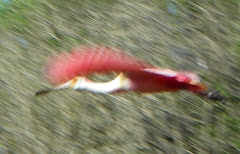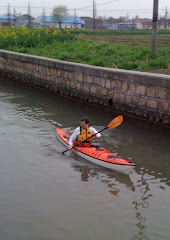Scotland 1934
In the 1930's John Marshall, a boat-builder in Scotland, designed a kayak along the lines of McGregor's "Rob Roy". This "Lochaber Canoe" measured 13 feet 6 inches long with a 32 inch beam. Marshall built it in three sections.
 |
| John Marshall (right) with a Lochaber Canoe. (Photo from his 1937 book Canoes and Canoeing.) |
|
|
The cockpit section was a canvas-covered wood frame about six feet long, with room for seating and cargo storage. By unlacing the deck, camping gear and supplies could be loaded either end against the bulkheads, leaving room for the kayaker. This gear doubled as a foot brace at the front, and as a back support behind the seat.
 |
| Plans for Lochaber Canoe, from book Quest By Canoe. |
Each pointed end section was a sealed flotation chamber with a canvas hull and varnished wood deck. All three kayak sections were held together by a wire that ran from the front bulkhead, over the bow, and following a groove the length of the hull, over the stern and back to the rear bulkhead behind the cockpit. The whole arrangement with bulkheads and sealed flotation chambers was quite different from the folding kayaks in use at the time. More manageable on land than a Rob Roy, the Lochaber kayak could be taken into pieces and reassembled quite quickly for easy transport.
 |
| "Quest By Canoe" by Alistair Dunnett, 1950. |
Two Lochaber Kayaks were used by Alistair Dunnett and Seumas Adam in 1934 to explore the western islands of Scotland by sea, a story later recounted by Alistair Dunnett in his book "Quest by Canoe: Glasgow to Skye", published in 1950. There are not many of Marshall's Lochaber canoes of these dimensions left. Possibly only one. I believe there is one at the Scottish Maritime Museum at Irvine, Scotland.
Newfoundland 1979
Planning a sea kayak trip in Newfoundland in 1979, Tim Franklin and I were perplexed as to how to ship our kayaks there from U.K. We tried to gain permission to have them flown by the military on a Hercules transport plane to Gander. The military made regular flights there with mostly empty planes. We were unsuccessful. In the end Air Canada came to our rescue. Their passenger flights to Gander from London Heathrow used TriStar jets. Baggage loading was containerized, but they offered us the option to fly our kayaks as accompanied baggage on our regular flight. To make this possible they they would provide a special container, longer than the ones they normally used. This would be the maximum length they could fit through the loading doors on the TriStar passenger jet: that is ten feet.
 |
| Nigel Foster and Tim Franklin with 2 Vynecks cut in half, 1978 |
Our kayaks (of my own design, the
Vyneck) were almost 18 feet long. There was only one way to make them fit, and our friend Graham Goldsmith at Gaybo, whose workshop built mostly fiberglass competition kayaks, and who later owned Perception UK, came up with a workable solution. He marked a line across the deck in front of the cockpit, back along the gunnels and across the hull in front of the seat. He drilled and bolted metal plates at intervals, crossing the line, then removed the plates and cut the kayaks in half.
 |
| Vynecks on the mini van, ready to drive to the airport, 1978 |
The sections were much easier to handle than full-length kayaks. We wheeled them from car to Air Canada check-in at London airport, where they fit easily into the container with all our luggage, including the fiberglass repair kit we would use to join the kayaks once we had aligned them straight using the metal plates. The day after arriving at Gender we reassembled the Vynecks in an aircraft hanger at the airport before someone gave us a ride with them to Gander Lake. From there we set off toward the Gander River, and eventually the ocean, where we began our sea kayaking adventure.
 |
| Tim (left) shows Newfies our kayaks, cut sections now joined again. |
We left the metal plates in position for extra strength, and the joins functioned perfectly. However, it seemed impractical and expensive to cut the kayaks in half a second time for a return journey so we left them in Newfoundland. By chance mine was discovered in a barn a few years ago and
fully restored. It now lives again in Newfoundland.
A different bolting solution
Cutting a kayak in half the way we did it is not the only way. A more typical method is to cut the kayak at the front and rear bulkheads, adding extra bulkheads to each open end. The sections then bolt together bulkhead to bulkhead. It takes some time and care to bolt together and make watertight, or to take apart again, and you have to reach deep into the cockpit to reach, but it is a solution used nowadays by several fiberglass kayak manufacturers.
 |
| A tandem kayak in two sections. You can see the bolts and holes on each bulkhead. (from book Nigel Foster's Sea Kayaking, first edition 1991.) |
21st Century Technology
Now in the 21st century Swedish kayak manufacturer
Point65 has produced a line of specially designed modular rotomolded plastic kayaks. With this molding process each section is built as a single watertight piece. There is no need to add bulkheads. Individual modules snap together with interlocking shapes providing structural integrity, while two easy bindings ratchet tight to lock them. Now you can assemble a solo kayak at the waters edge in seconds, convert it to a tandem with the addition of another section, add more for cargo or additional paddlers and yet carry in manageable pieces and transport the sections inside a car.
 |
| Bow and stern sections of a Point65 Martini, with a mid section in the car. |
In the same way that Alistair and Seumas assembled their kayaks and set off on their paddling adventure in Scotland in 1934, 79 years later in summer 2013, Paul Everitt (
going-solo.co.uk) launched solo at the Swedish border with Norway and headed toward the Baltic Sea. He was later joined by his girlfriend Kelly Durst and they paddled tandem for the rest of the season.
Modular is not for everyone, but the easy portability and storage, and the quick snap-together/snap-apart system, offers great possibilities for many who would otherwise not be able to kayak. It offers flexibility to go solo, tandem or more, with just one kayak, simply clipping together extra sections when needed.
 |
| Rolling a modular Point65 Mercury with 4 seats. |




































































